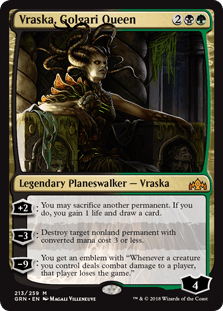Removal in Legacy has to be flexible. With only a few sideboard slots to spare, your options post-board need to be able to answer a plethora of threats ranging from evasive creatures to planeswalkers to pesky artifacts and enchantments. Fortunately for Legacy Maverick players, thanks to your colour pie, you have access to some of the best removal in the format. Here are some options for flexible sideboard and even main deck-able removal spells.
Council’s Judgment
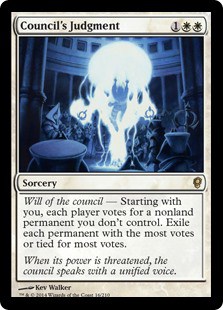
Council’s Judgment is Maverick’s best universal removal spell – period. As an answer to format staples like Umezawas Jitte, Wrenn and Six and Blood Moon, Council’s allows you to get out of some very awkward boardstates. It is unique in that it’s not targeted removal. This means Mother of Runes / Giver of Runes cannot give protection to gain any advantage and Hexproof & Shroud – to put lightly – doesn’t mean jack.
At 3CMC, it’s never being awkwardly locked out by your own Gaddock Teeg and even with a Thalia, Guardian of Thraben in play, it’s still a great 1-for-1 at 4 mana. One small advantage I really like about Judgment is that once it’s on the stack it may cause your opponent to make plays that don’t work out well for them.
Let’s take the example of your opponent having a creature on board alongside a Jitte with 3 counters. With Judgment on the stack, your opponent now has to decide what you’re most likely going to vote for and if they need to do anything before letting it resolve. Do they use the Jitte counters to gain life? Do they leave the counters so that it’s not the more appealing choice? It’s a case of ‘it depends’ in most situations. However, there are many where if my opponent goes to gain 6 life from the Jitte and then lets the Judgment resolve, I’ll go for the threat and leave the equipment.
Another example is if your opponent has a Gurmag Angler, Leovold, Emissary of Trest and Karakas in play when you cast Judgment. If you want to deal with the Angler and your opponent bounces their own Leovold in response to Judgment, that’s a huge tempo swing. These are just some of the cases of playing mind games on your opponent when casting Council’s Judgment. Also note that Council’s Judgment does not trigger Leovold’s static ability as it does not target anything.
Pros:
- Deals with virtually any threat, including the troublesome True-Name Nemesis.
- Plays around protection effects and abilities.
- Naming takes place after resolution.
- Can be played in any variant of Maverick (as they are GW based).
Cons:
- Casting cost of WW can be troublesome at times.
- Sorcery speed removal cannot deal with EOT, game-ending threats like Marit Lage.
Oblivion Ring / Banishing Light
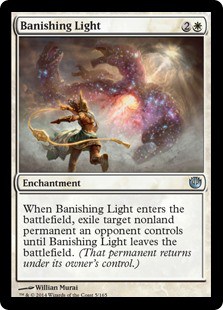
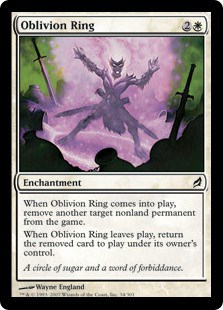
Call it old-tech but these two are great choices in the right meta for sideboard removal. If you’ve ever played against Show and Tell, you know how backbreaking these enchantments can be. Let’s quickly run through the actual differences between them and why you want to play Banishing Light over Oblivion Ring in Maverick.
Oblivion Ring:
1. Oblivion Ring can target any non-land permanent on the field. This includes your own permanents. This means if you have a permanent (let’s say a Knight of the Reliquary) on the field and your opponent also only has one permanent ( Baleful Strix), casting Oblivion Ring can backfire on you if your opponent has removal for their permanent. An example might be in response to you casting Oblivion Ring, your opponent casts Lightning Bolt targeting their own Baleful Strix. Now that the only permanent on the field is Knight of the Reliquary, it’s going to get exiled by your own Ring. This may be a huge advantage to your opponent because not only have you removed your own threat, it may have been one that they didn’t have an answer to.
2. Oblivion Ring has not 1, but 2 triggers. This means “If Oblivion Ring leaves the battlefield before its first ability has resolved, its second ability will trigger and do nothing. Then its first ability will resolve and exile the targeted non-land permanent forever.” – Gatherer.
Here’s an example of how that’s relevant for Maverick:
i. You have a Qasali Pridemage in play staring down a UW Miracles opponent’s Monastery Mentor.
ii. You cast Oblivion Ring and your opponent lets it resolve.
iii. With the ETB trigger of Oblivion Ring on the stack, you use Qasali’s ability to destroy the Ring. Oblivion Ring is now put into the graveyard and its LTB trigger happens, doing nothing because the first ability exiling the Mentor has not resolved yet.
iv. The ETB trigger of Oblivion Ring now resolves, exiling the Mentor forever.
The only reason you’d make the above play is if you thought your opponent had removal for the Oblivion Ring (such as Disenchant effects) and you wanted to make sure the Mentor was dealt with. Although it’s technically a play, it doesn’t come up often and I wouldn’t say this is a great reason to play O-Ring over Banishing Light. This type of play comes up much more in older Death & Taxes lists where you can make the same sort of play with Flickerwisp on Oblivion Ring.
Banishing Light:
- Banishing Light can only target non-land permanents and opponent controls.
- The exile and return effect happens at once, so there is no room for shenanigans like above with Oblivion Ring.
“Banishing Light’s ability causes a zone change with a duration, a new style of ability that’s somewhat reminiscent of older cards like Oblivion Ring. However, unlike Oblivion Ring, cards like Banishing Light have a single ability that creates two one-shot effects: one that exiles the permanent when the ability resolves, and another that returns the exiled card to the battlefield immediately after Banishing Light leaves the battlefield.” – Gatherer.
One issue I do have with these enchantment-based answers is they are not a straight-up answer. Your opponent may be able to remove them after resolving and retrieve their threats. However, there are some decks that don’t – decks like Grixis Control or UR Delver which don’t have access to cards like Nature’s Chant, Disenchant or Abrupt Decay.
Pros:
- Can be put into play off Show & Tell.
- Can answer a wide variety of threats.
- Some archetypes don’t run enchantment removal.
Cons:
- Sorcery-speed removal.
- They are a band-aid on a bullet wound most of the time (can be removed from play easily).
- Adds a card type that usually doesn’t see much Legacy play to the graveyard (Grows the Goyf).
Assassin’s Trophy

Assassin’s Trophy is another great multipurpose removal spell that does come with a small downside: it can ramp your opponent. Trophy is, of course, going to peak effective against decks that don’t play basic lands, your Dredge, RUG Delver and sometimes Eldrazi archetypes of the format.
When spoiled, Assassin’s Trophy was seen as a Legacy playable removal spell that Maxtortion pointed out on release: “While most cards get worse in multiples, interestingly, Ass Trophy actually gets better in multiples, and in conjunction with Wastelands.”
Trophy can answer permanents from Tarmogoyf to Jace, the Mind Sculptor, to Endbringer to Dark Depths or Karakas. Trophy is on par with Council’s Judgement when it comes to versatile removal spells, as it’s an instant speed 2CMC Vindicate in many situations. Because of the power of Trophy, I didn’t feel the need to discuss budget considerations like Vindicate, Beast Within or Anguished Unmaking. But these are OK budget options in the right metagame.
However (and there is a however), the downside of your opponent getting an untapped mana source is pretty huge, especially in a format as powerful as Legacy. Maverick does have a great mana denial strategy built into the deck through Wasteland and Thalia, so when assessing Trophy as a removal spell, it may seem a little counter-intuitive to what the deck wants to achieve.
One reason I currently don’t like Assassin’s Trophy is because, in my opinion, Spell Snare is the best non-free counterspell in Legacy right now. Wrenn & Six, Tarmogoyf, Snapcaster Mage, Vampire Hexmage, Dreadhorde Archanist, Infernal Tutor, Sylvan Scrying, Dark Confidant, Stoneforge Mystic , Thalia, Guardian of Thraben. No, I’m not just naming some of the most popular cards in Legacy’s metagame – I’m naming some of the targets on Spell Snares hit list.
Pros:
- Versatility. Unlike other removal spells you can destroy land.
- Instant-speed effect means you have more control over when and what you target.
Cons:
- It ramps your opponent and may even fix their mana issues. This is not great in a deck that’s also looking to take your opponent off mana and make their spells cost more.
- Can only be played in the black-splash variants. This is also an issue as, in a Wasteland-heavy meta, you are opening yourself to matches where you won’t have the mana to use Trophy.
Abrupt Decay
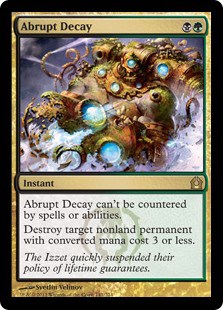
Abrupt Decay is restricted in the sense it only deals with threats below 3CMC, but this doesn’t stop it from being one of the premier removal spells in Legacy. From Delver of Secrets to Blood Moon, to Sylvan Library or Wrenn & Six, Abrupt Decay has your back as a reliable way to deal with these threats – every single time. The feeling of having an uncounterable removal spell is a huge weight off your shoulders when it comes to the Legacy format and the dominance of blue-based strategies. No worrying about having the mana up for Daze or Spell Pierce – not even the premiere counterspell in Force of Will can stop you from Decaying a threat.
I’m a huge advocate of maindeck Decays right now as the metagame is quite low when it comes to overall CMC. Sure, it’s not the greatest against fast combo, but on the off chance your opponent has misplayed their Lion’s Eye Diamond out too soon or your Reanimator player has gone with Animate Dead as their reanimation spell of choice, it’s not always just a dead card.
Decay is also great against the creature-based decks or those blue decks that rely on their Delvers, Dreadhordes our Tarmogoyfs to get their victory.
Pros:
- Cannot be counted. This is a huge asset against fast Delver starts where Swords to Plowshares just doesn’t cut it.
- It only costs 2 mana and can be kept open during your opponent’s turn, with little tempo lost.
- Deals with 90% of the format’s threats and is hardly ever a dead draw in G1 when played in the maindeck.
Cons:
- Like Assassin’s Trophy, this card can only be played with the black splash.
- Against decks like RUG Delver, you’re very open to being Wasteland-ed off your black mana, so relying on Decay may cost you some games.
- The 3 CMC restriction means this isn’t an out for Reality Smasher, Jace the Mind Sculptor or Sneak Attack.
Blast Zone
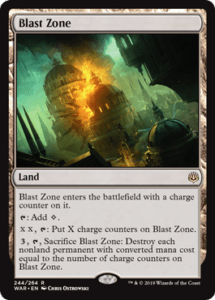
Shout out to Reddit User Jadedstranger for reminding me Blast Zone exists and is a great choice to fill a maindeck flex slot as extra removal. Not only does Blast Zone deal with G1 True-Name Nemesis and planeswalkers such as Jace, Oko, and if you’re lucky, Wrenn & Six, the utility of Blast Zone is its true power.
Unfortunately Blast Zone doesn’t interact well with Back to Basics or Blood Moon, however if you play it under a moon effect against a deck like Mono-Red Prison and then remove the Moon effect, you now have yourself an active Blast Zone with no counters on it and more importantly, a sweeper effect for any Goblin tokens or Chrome Mox.
The biggest advantage of Blast Zone is that it’s tutorable removal through Knight of the Reliquary or Elvish Reclaimer, something other removal in Maverick lacks (outside of Qasali Pridemage & Knight of Autumn).
Similar to Pernicious Deed, Blast Zone’s ability is reciprocal, meaning if you want to removal that TNN you’re also going to lose your Knight. This is a big downside as Maverick is a deck that tends to pressure opponents by going wide on-board with a number of different permanents. You don’t want to activate Blast Zone if you’ve got more permanents of the same CMC as the threat you’re wanting to void, but at the same time if it’s going to get out of hand it’s a move you may have to make.
Note that Blast Zone itself cannot kill tokens as it enters the battlefield with a counter on it. However, if you also run Thespian’s Stage and copy your a Blast Zone, the new copy will have no counters on it and will be able to blow up 0 CMC non-land permanents including tokens.
Pros:
- Has many applications and is flexible enough to deal with specific board-states
- Can be tutored for at instant speed
- Cannot be countered. Some archetypes won’t even have an answer for it postboard
Cons:
- It’s a mana sink that takes time to get online (high CMC targets)
- It comes in tapped and is very open to removal right now in Wasteland
- You may have to sacrifice some of your own permanents if you want to to activate its ability
- With Vampire Hexmage in the format right now it can be a little awkward to get Zone online
Red Elemental Blast / Pyroblast
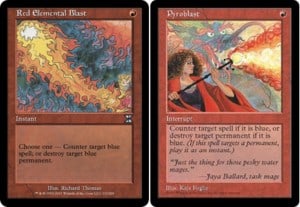
As one of the biggest reasons to splash red in Maverick, Red Elemental Blast and Pyroblast deal with permanents such as True-Name Nemesis (on the stack), Jace, the Mind Sculptor, Back to Basics and more relevant right now that all of these, Oko, Thief of Crowns. A the cost of a single mana, we have the most mana efficient answer on our list and what should be taking up 2-3 slots in your Punishing Maverick sideboard.
For those who want to know more about the difference between these, here’s a breakdown from the mtgsalvation forum.
“There’s a slight difference. Red Elemental Blast can only target blue spells and blue permanents; Pyroblast can target any spell or any permanent, it just doesn’t DO anything if they aren’t blue. So, if you use something to shift targets around, you can only change REBlast’s target to a different blue spell/permanent; you can shunt Pyroblast onto any spell or permanent, it just won’t do much unless the new target happens to be blue.“
Honorary Mentions:
These are cards that pop up from time to time in sideboards of winning lists but aren’t as staple to the deck as some of the spells above. I wanted to touch on these as they are quite powerful in the right metagame.
Vraska,Golgari Queen
Vraska does see some play from time to time in the sideboard of GWB Maverick, and plays a solid role against midrange and control decks as a hard-to-answer threat. Vraska is literally an Abrupt Decay that sticks around after to evoke even more pressure. I’ve had some testing with Vraska and did make use of her +2 with land in some of the long, drawn-out matches. She allows you to turn any sort of mana flood or creatures that are no longer relevant into a new card, which is something Maverick isn’t too used to. In the past, card draw itself has predominately been brought to the archetype through Sylvan Library or Sword of Fire & Ice.
Do not underestimate the small amount of life you can also gain off Vraska – sometimes enough to get that vital extra turn you needed to turn the match in your favour. However, she is 4 CMC, locked out by an on-field Teeg and a hefty 5 mana if Thalia is in play. Garruk Relentless is another 4CMC Planeswalker that has seen play, so until you test her out for yourself, don’t cut her short of being a great choice for your sideboard and meta.
Celestial Purge
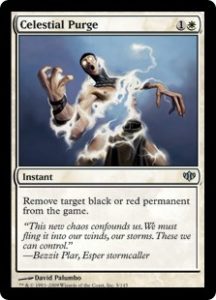
Lastly, I wanted to touch on Celestial Purge. It deals with an array of opposing threats and takes out three of the biggest boogeymen of the format in Wrenn, Plague Engineer and Marit Lage. It’s also a house against the Mono R Prison archetype and newer format threats such as Dreadhordge Archanist and Hoggaak. Purge is a great card that, I believe, should be in every board in the right meta, but right now may be a little too narrow with the amount of non-black-or-red permanents running around right now (Oko, Tarmogoyf, Delver of Secrets, Mentor to name a few).
Conclusions:
I hope you’ve learnt some new interactions or uses for the removal discussed above. If you’re wanting to run extra main deck removal, 2 Abrupt Decay or a Council’s Judgment is likely your best bet.
You can buy these singles and many more through the site to help keep it alive!
If you’re after any of these cards, you can either purchase them through TCG Player or Cardhoarder by hovering over card name OR by visiting the singles page. Please keep an eye out for the next edition of Removal in Legacy Maverick as we discuss answers for artifacts & enchantments and creatures. If you have any thoughts on other universal removal, comment below or reach out to me on my social’s below.


